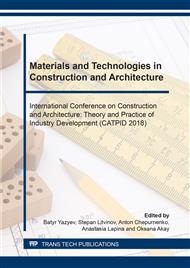[1]
V.P. Generalov, Features of design of high-rise buildings, Samara State Architectural and Construction University, Samara, (2009).
Google Scholar
[2]
V.I. Shumeyko, E.V. Pimenova, M.N. Grigoryan, High-rise, unique buildings and structures, Rostov State University of Civil Engineering, Rostov-on-Don, (2014).
Google Scholar
[3]
V.I. Shumeyko, E.V. Pimenova, T.V. Poliakova, Features of designing high-rise, unique buildings and structures, Rostov State University of Civil Engineering, Rostov-on-Don, (2015).
Google Scholar
[4]
Information on: http://www.skyscrapercenter.com/building/kingdom-centre/494.
Google Scholar
[5]
Information on: http://www.skyscrapercenter.com/building/shanghai-world-financial-center/131.
Google Scholar
[6]
Izengard, energy, High-rise Buildings. 1(2012) pp.29-33.
Google Scholar
[7]
Information on: https://www.asianarchitecture.info/Building/3193/Incheon-Tower.php.
Google Scholar
[8]
Information on: http://www.skyscrapercenter.com/building/bahrain-world-trade-center-1/998.
Google Scholar
[9]
Information on: http://www.skyscrapercenter.com/building/intempo/1676.
Google Scholar
[10]
Information on: http://building.en-arian.com/elephent_structure.
Google Scholar
[11]
V.I. Shumeyko, E.V. Pimenova, Modern trends in the design and construction of high-rise buildings, Construction and architecture-2017, Rostov-on-Don, 2017, pp.113-119.
Google Scholar
[12]
E.M. Generalova, V.P. Generalov, A.A. Kuznetsova and O.N. Bobkova, Mixed-use development in a high-rise context, E3S Web of Conferences 33, 01021 (2018), Information on: https://doi.org/10.1051/e3sconf/20183301021.
DOI: 10.1051/e3sconf/20183301021
Google Scholar
[13]
Information on: http://www.skyscrapercenter.com/building/marina-bay-sands-hotel-3/2732.
Google Scholar
[14]
Information on: https://ecotechnica.com.ua/arkhitektura/3216-v-kitae-stroyat-gigantskij-neboskreb-s-gorizontalnoj-bashnej.html.
Google Scholar
[15]
Information on: https://en.wikiarquitectura.com/building/cctv-headquarters.
Google Scholar
[16]
Information on: https://www.japanhoppers.com/ru/kansai/osaka/kanko/261.
Google Scholar
[17]
Information on: http://www.skyscrapercenter.com/building/id/15527.
Google Scholar
[18]
A.В. Korotich, Paradigms of composition and art development of modern high-rise architecture, Architecture: Universities Bulletin 1(61) (2018). Information on: http://archvuz.ru/2018_1/2.
Google Scholar
[19]
Information on: https://www.arch2o.com/doughnut-shaped-skyscraper-guangzhou-joseph-di-pasquale-architects.
Google Scholar
[20]
E.V. Pimenova, V.I. Shumeyko, Transformation in the architecture of unique public buildings, The Don Engineering Herald (Rus). 43(4) (2016). Information on: ivdon.ru/ru/magazine/archive/n4y2016/3939.
Google Scholar
[21]
M.A. Korotich, A.В. Korotich, Compositional features of structural forming of high-rise buildings, Academic Herald Ural SRI project RAASN, 2, (2009).
Google Scholar
[22]
Information on: https://www.arthitectural.com/ua-studio-7-shenzhen-bay-super-city-international-competition.
Google Scholar
[23]
P.P. Semikin, Principles of formation of architecture of high-rise buildings with renewable energy sources, synopsis pf Candidate of Architecture thesis, Moscow, (2014).
Google Scholar


